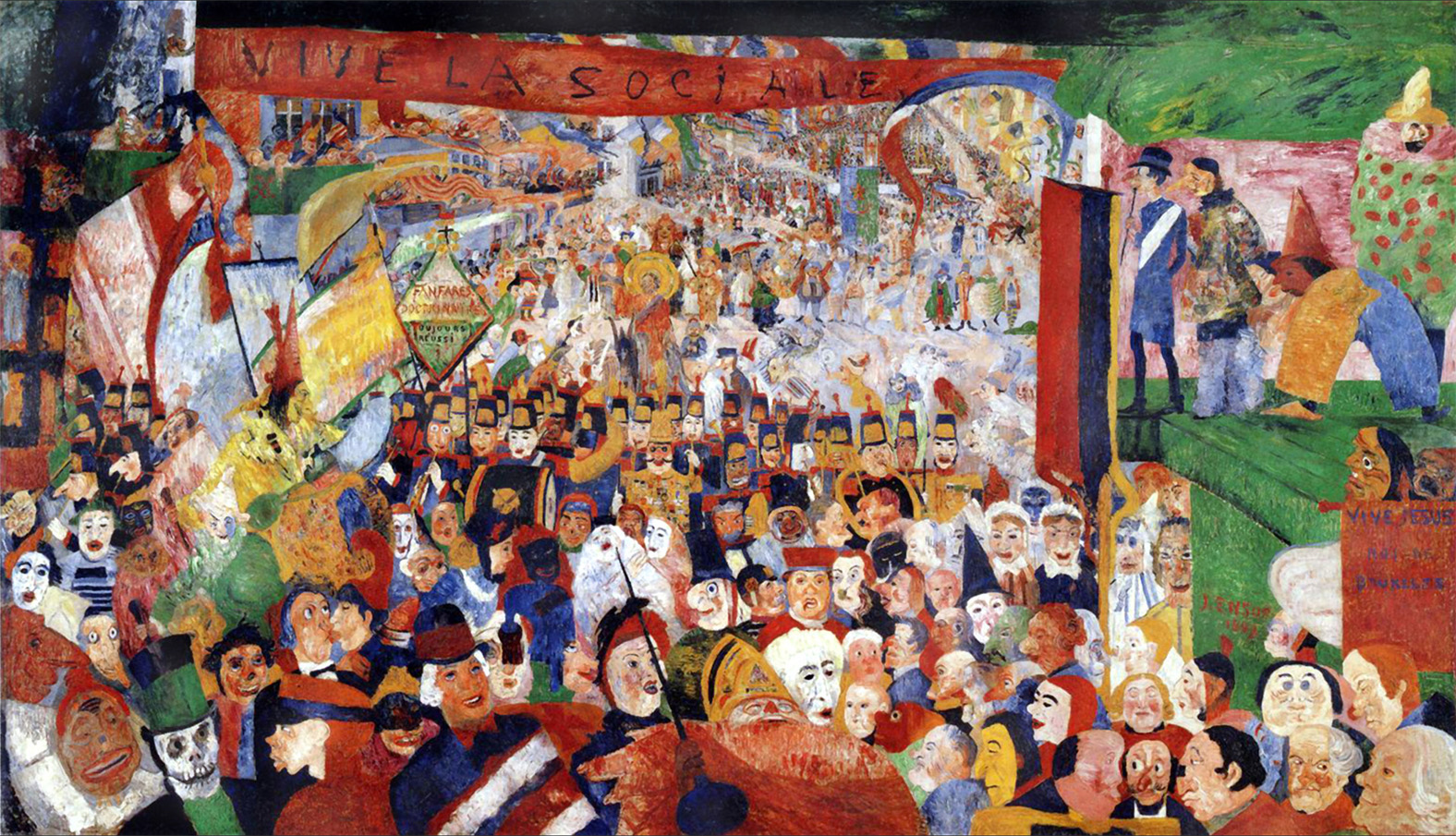We are currently starting a church in Brussels, the capital of Belgium and of Europe. So when we first came across James Ensor’s Christ’s Entry into Brussels in 1889, the painting naturally caught our attention. The 8×14 feet canvas depicts the imagined entry of the messiah on one of the new modern boulevards of the city and is “one of the most extraordinary and prophetic works of art produced anywhere in Europe,” according to art historian Patricia G. Berman. [1]
Whose Entry?

The name of the painting starts with “Christ.” But . . . where is Christ? A bit like the game Where’s Waldo? his presence isn’t immediately noticeable. Have you found him yet?
He is there, but in the background, riding on a donkey. It looks like most people are too busy with their own partying and parading to notice him. The foreground of the painting is instead occupied by sarcastic caricatures of the most powerful of Brussels: the politician, the bishop, the businessman, the army commander, and many others. Have you found them yet?
Brussels was still a backwater city at the beginning of the 19th century. But when the young Belgian artist painted Christ’s Entry, King Leopold II—an alliance of the military, religious, and political authorities of the city—was succeeding in turning Brussels into one of the most powerful cities of Europe. However, the glorious rise of Brussels was implemented with little regard for the oppressed laboring classes and became increasingly dependent on the pillage of the Congo. (Have you found the Congolese mask yet?)
Today as well, the risks of power abuses are high in Brussels as the city is once again going through an amazing transformation and becoming the new capital of Europe. It’s now ranked as the fifth-most influential city in the world because of its political power. Surprisingly, however, one Brusselite out of four is living below the poverty line.
Whose Donkey?
The face of the Christ in the painting is actually a self-portrait of Ensor. The 28-year-old artist painted himself sitting on the donkey. He was completely disillusioned with the institutionalized power of Belgian officialdom and promoted, as an alternative, the radical freedom of the individual. His painting reflects the ambition of a generation to reconstruct the world on the basis of individualism and rejecting authority. Ensor, as an artist, was bearing the responsibility to make space for that freedom and entering Brussels as the overlooked redeemer of the city.
Similarly in Belgium today, we tend not to trust the authorities of our country; we cherish dearly our individual freedom. “Let everyone remain his own master” [2] is a practical guiding principle for all of life, according to Belgians. But the disenchantment Ensor once had with the public institutions now extends to our individualistic way of life. “Disillusion, With a Dance Beat.” That’s how The New York Times rightly characterized the songs of Belgian singer Stromae, who is currently making everyone dance in Belgium. Our jealously guarded individual autonomy and independence seem not to offer much in the face of our country’s pessimistic and depressing mood.
Christ Is Entering Brussels
To those who have eyes to see, the painting will nevertheless prophetically proclaim truly Good News: Christ is indeed entering the city of Brussels. His voice is still dim in the capital of Europe; he is not well represented. The last evangelical church for Brusselites of Belgian origins was planted 13 years ago. But we know that Christ is a good king, never misusing his power; he is the true redeemer of Brussels. We love our city, and this is why we are starting a church.
Redeemer City to City helps local leaders start churches in global cities. Matthieu Klass is starting Église Protestante de la Cambre in Brussels. You can follow their progress and give directly to this new church through their projects page on City to City.
Église Protestante de la Cambre, Brussels from Redeemer City to City on Vimeo.
[1] Patrica G. Berman. James Ensor: Christ’s Entry into Brussels in 1889. Los Angeles: Getty Publications, 2002. 6.
[2] Elisée Reclus. “Introduction” to Peter Kropotkin, Words of a Rebel. Montreal and New York: Black Rose Books, 1992. 18.
Is there enough evidence for us to believe the Gospels?
 In an age of faith deconstruction and skepticism about the Bible’s authority, it’s common to hear claims that the Gospels are unreliable propaganda. And if the Gospels are shown to be historically unreliable, the whole foundation of Christianity begins to crumble.
In an age of faith deconstruction and skepticism about the Bible’s authority, it’s common to hear claims that the Gospels are unreliable propaganda. And if the Gospels are shown to be historically unreliable, the whole foundation of Christianity begins to crumble.






























